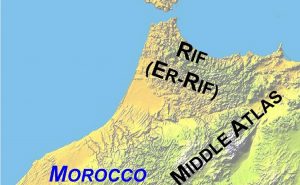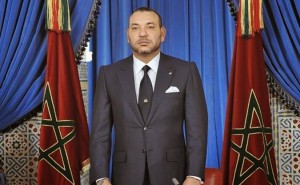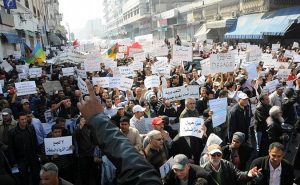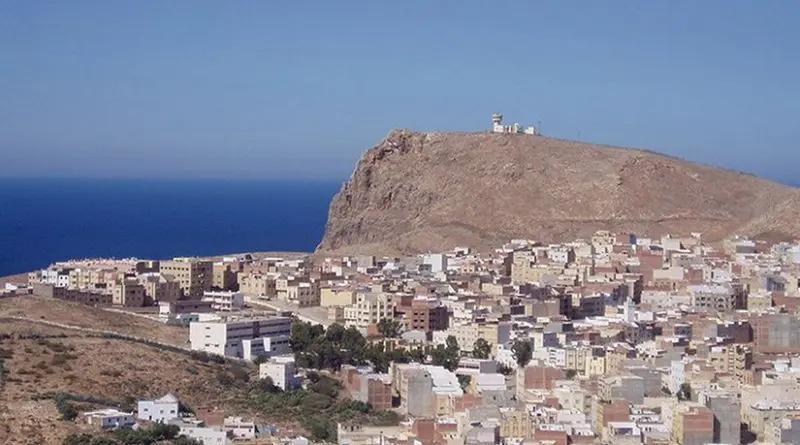The Reasons For The Rif Revolt – Analysis
The Rif has, in spite of itself, has become involved in a peaceful revolt since the death of the fishmonger Mohcine Fikri at the end of October 2016,i a dramatic situation that seems to have no outcome at the moment. Worse, there is an escalation of tension from both the Hirak (uprising) and the government: Nasser Zafzafi, the icon of the popular Rifi protest movement, clumsily attacked the sacredness and the sanctity of the Muslim religion in a very conservative country, and the government automatically and hastily proceeded to arrest him along with his circle of lieutenants and decision-makers.
In this regard, Kenza Oulmlil, an assistant Professor in Communication and Gender at Al Akhawayn University in Ifrane, Morocco, argues in Al Jazeera electronic portal publication on June 6, 2017:ii
“As well as being accused of “obstructing the freedom of worship”, Zefzafi was also criticised for the lack of structure and eloquence in his intervention at the mosque. The protest leader, who is not a highly educated person, was accused of being a misogynist after making comparisons between the political corruption in the country and the “corrupt mores of women”, criticising the way women dress and even using language that implies men’s “ownership” of women. This is indeed a worrying discourse, especially for women who are concerned about not losing control over their bodies. But the Hirak Movement recently sent out a more egalitarian message by including a woman, Nawel Ben Aissa, among the leaders of a protest following Zefzafi’s arrest.”

It seems that on both sides impulsiveness has largely prevailed over wisdom and common sense and as a result the gap will expand further, yet a peaceful and responsible dialogue could have readily resolved the conflict bearing in mind that the government has promised to put $1 billion on the table, a tremendous amount, for the much-needed development of the city and its surroundings. In short, no city or region of Morocco has had the chance of such governmental generosity at once and as quickly. It is a boon for the Rif if the promise is respected, of course.
But, however, it must be said openly that the Rif has been suffering stoically and in silence for over a century. Indeed, since the beginning of the last century, it has suffered greatly from the yoke of harsh French and Spanish colonialism and since the independence in 1956 of the contempt of the central state without forgetting the harshness of nature and all this can seen on the face of the Rifi people, who are victims of abject poverty and horrendous injustice.
Structural Handicaps
The Rif as a region and as a cultural entity has been confronted, for a long period of timen with a range of handicaps both natural and human:iii
Geographic Handicap
The Rif is a predominantly mountainous region and very steep and therefore generally rugged. It has few plains. The slopes of the soil are often very strong and with an inclination of more than 50%. The soils are not very permeable and are, thus, very sensitive to erosion. Although it has access to an important rainfall, in a wet year, however it is arid and badly lacking water most of the time. The Rif in its entirety is subject to devastating and continuous erosion.
Cultural Handicap
In the popular imagination of the Moroccans, the Rifis are at the same time very brave and very honest people, responsible heads of families and loyal spouses. They are known by the name of shluH al-‘azz, the valorous Amazighs / Berbers.
That said, however the Rifi is seen and stereotyped as a shady and unfaithful being who can change his mind and camp quickly:
- Rifi gheddar u qattal (the Rifi is sanguinary and incapable of fidelity);
- Rifi diru guddamek u ma-tidiru urak (The Rifi is not trustworthy);
- Rifi ighadrek, ighadrek (the Rifi will be unfaithful to you sooner or later), etc.
These strange stereotypes about the Rifi individual are the result of his pugnacity and innate sense of survival in an inhospitable geographical and human environment. His face, cicatrized by the hardships life, gives him the impression of being a patient sufferer and untrustworthy man with a natural propensity to fight and aggression.
Economic handicap
The Rif is a basically poor region; mountainous and arid and therefore unable to feed its own people. In the thirties of the last century the Rifis immigrated seasonally, en masse, to French Algeria to work in agriculture. They called this movement shareq “migration to the east”. In the 1950s, they crossed, this time, the Mediterranean to go to Europe which was in full reconstruction after the Second World War, thanks to the American generosity of the Marshall Plan. They settled mainly in Holland and Belgium but also in Spain, France, Germany and the countries of Scandinavia. Thanks to the hard earned money they fed their families, built beautiful houses and invested in businesses and real estate in their area tribal areas and elsewhere in Morocco.
But in the 1980s, the Europeans closed their borders and the sons of the Rif turned to education with the hope of getting a job to take care of their families and make their living. Once the diploma in hand they were confronted to the harsh reality of the labor market: selective and not generous, in the least. Their survival hopes were bashed on the rocks of ferocious liberalism. On the chairs of the cafes they meditated at length on better days while organizing themselves in associations of defense of the Amazigh/Berber culture and human rights. Soon Alhoceima became the Moroccan capital of human rights and contestation.
To calm the region, the Makhzen proceeded clumsily to the co-optation of some local elites, but soon these elites lost their political “virginity” and credibility were disavowed by the Rifi people, not to say socially banished.
The Rif Bruised By Official Morocco
The armed uprising of the Rif of 1958-59 was not directed against the monarchy but rather against the Istiqlal Party, which wanted to seize power to establish the single party political system, as was the case in several Arab countries. The would be king Hassan II, who was crown prince Moulay Hassan, anxious to become king in the place of the king, saw in this uprising a golden opportunity to assert his political and military authority and get rid of both the disturbing Rif and the usurper Istiqlal political party. Against the advice of his father Mohammed V, rather inclined to political dialogue and social intermediation. Moulay Hassan crushed the Rif uprising militarily in blood.
At the end of January 1959, the uprising was suppressed by a military force of 30,000 men commanded by crown prince Moulay Hassan and placed under the orders of General Oufkir. After the end of the uprising, the Rif was subjected to a military regime for several years and the most ruinous legacy of this uprising was the complete neglect and marginalization of the region by the Moroccan authorities in the following decades.

This marginalization was to become even more pronounced after the popular uprising of 1984, which was also repressed in blood because, for Hassan II, the Rif was still militarized and the region still openly opposed to the monarchy and the state.
On his accession to the throne in 1999, Mohammed VI begun a process of reconciliation with the Rif, making several trips to Alhoceima and Nador and inaugurating a number of large-scale projects, but not sufficiently meeting the urgent needs of the population: employment and dignity. The good intentions of King Mohammed VI for the development of the Rif were totally exasperated by administrative delays, bureaucratic sluggishness, corruption of elected officials and poor choice of local elites.
Morocco In Despair
During the 1912-1956 colonial protectorate, France, for the purpose of domination, had divided Morocco into two parts: Useful Morocco (Maroc Utile), made of coastal commercial centers, rich agricultural plains and areas with mineral wealth, and Unnecessary Morocco (Maroc Unutile) that of rugged mountains, rural plateaus and scorching desert territories. This subdivision coincided greatly with an older one: bled l-makhzen “land under government control” and bled siba “land of dissidence” or rather the poor regions of the Amazigh/Berbers who refused to pay taxes to the central government, because of poverty but recognized his religious mantle as the “Commander of the Faithful,” Amir al Mu’minin.
After independence, this subdivision persisted; indeed, today one can distinguish between two Moroccos that are cruising at two different speeds: A Morocco of the “golden triangle” and a Morocco of the “triangle of despair.” The golden triangle extends from Laayoune in the south to Tangier in the north and Fez in the east and all the territories that are situated outside this triangle is the world of despair, generally the Amazigh/Berber lands, lacking badly resources and infrastructure.
Since independence the government has clumsily and irresponsibly directed all investments, national or international, towards the golden triangle creating multiple possibilities of work, therefore much wealth and well-being. On the other hand, outside of this triangle, the idle youth is in total despair and families are crushed by poverty and lack of means and are full of anger and hate towards the establishment for their lot which they consider a form of humiliation (Hogra) resulting from lack of interest in them and in their plight.
The Drop That Overflowed The Vase

The emotional earthquake that Morocco experienced on October 30, 2016 following the death of Mohcine Fikri was undoubtedly a very dangerous event for the future of the country. The political class and the establishment must have drawn the necessary lessons for the future of the country, then. Today, it must be said that the future is very bleak and the so-called “Moroccan exception,” if any, is in great danger of extinction.
The Hirak of the Rif is the natural outcome of the discontent of the Moroccan “triangle of despair” in its totality. The events of Alhoceima are maybe, to be clear, the Moroccan spring in the making, unless the demands of the population are met at once. This popular movement has undoubtedly exposed the precariousness of the Amazigh/Berbers and the reality of the political game in Morocco. The political parties have all been co-opted by the Makhzen and, as a result, have lost their political “virginity” in the eyes of the population and the people themselves have, thus, become the legitimate and real opposition on the ground because nature does not like void, and so they went down to the streets to defend their dignity and safeguard their interests and shout out their doldrums and voice their discontent.
The Hirak of the Rif is peaceful and legitimate, the state must imperatively take charge of it: listening, dialogue, intermediation and reactivity and mute the calls of security sirens who want to demonize the protesters and push Morocco into uncertainty. Morocco is a country of dialogue and the middle ground, but it is going very badly now and the monarchy, as in the past, has to put itself at the bedside of the sick poor to nurse them back to good health.
In Morocco today there are two distinct classes: the rich, which is made up of politicians, industrialists, financiers, rentiers, bourgeoisie, etc., rich as Croesus and the ordinary people, the grassroots and the destitute who live from day to day in total poverty. As a reminder, the middle class that serves as a “shock absorber” between the rich and the poor disappeared from the Moroccan social scene a long time ago.
PJD, A “Paracetamol” That No Longer Calms Pain
In 2011, at the height of the Arab Spring, the king, as a good and loyal firefighter, proposed to the Moroccan people a constitution for a future true constitutional monarchy. This document opened the door wide for the arrival of the Islamists to power, which materialized soon after with great pomp.
For 5 years, from 2011 to 2016, the Islamist “paracetamol” calmed the multiple pains of Moroccan society without having succeeded in any way in diagnosing the real ailment. To justify their inability to solve the major problems and evils of the country, as they approached the end of their term in October 2016, they evoked the concept of ta7akkoum (remote control power), which, in plain terms, means that the major political decisions remain in the hands of the shadow cabinet (entourage of the monarch), not to say, of course, the hands of the sovereign himself.
But, according to Intissar Fakir, writing in Sada on Novemner3, 2016, the real center of power is the monarchy and its entourage:iv
“The dichotomy of Moroccan politics is such that political actors and elected officials are traditionally held accountable in public rhetoric, but they wield the least authority when it comes to governing and decision-making. The powers that are firmly in control—the monarchy and its vast circle of advisors, administrators, and officials—remain above accountability and questioning.”
The Islamists wanted badly to justify their political failure to clear themselves from the wrath of their electors. It is true that certain decisions can be influenced by the royal entourage but their intrusion is, definitely, very minimal. However, to the astonishment of many, they were re-elected with more seats in parliament but less political bite, on a purely religious and non-economic agenda, of course.
The Fear Haunting The People Is Unemployment And Humiliation (7ogra)
During their many electoral campaigns, the PJD and the rest of the political parties make hollow promises to the common people, to provide ample employment for them synonymous with dignity.
Generally all Moroccan political parties make promises without basing themselves on previous planning, scientific studies or academic research. In short, Moroccan political parties have no economic strategy or other program and cannot create the jobs so much needed and desired by people to survive in a savage and inhuman liberal economic system. These parties have only political literature that they are updating in the run-up to the electoral deadlines, hence their popular strident failure in recent years.
Disappointed of the performance of Moroccan political parties, the people do not even deign to vote: October 7, 2016 general elections: 57% of abstention. The abstention, however, does not arrange in any case the perpetual complaints of the Moroccan people who suffer of poverty and lack of opportunity.
What To Do?
The Hirak is a social and economic protest movement brandishing a legitimate list of grievances of an Amazigh/Berber region battered by political and economic marginalization, but it is, also, a time bomb that can explode at any moment and destabilize the country, If not the whole region and initiate the second wave of the MENA spring.
The people of the Rif are unionists and not separatists. They are proud of their Moroccan identity, no doubt about that. The Ait Ouriaghel tribe defeated Spain under Ben Abdelkrim al-Khattabi over the years 1921-1926, for the greatness of Morocco and the Gzennaya tribe defeated France in the “Triangle of Death” in October 1955, for the country’s independence and the end of the protectorate.
Unfortunately, in spite of the great services rendered to the nation by the Rif region, Rabat marginalized it because it apparently had wounded Hassan II in his ego and his own self love, so much so that he had forgotten that he was the king of all Morocco before being the citizen Hassan Ben Mohammed.
To avoid the general explosion and the domino effect of the Alhoceima movement, it is essential to undertake the following steps urgently:
Short term:
- Urgent Royal intervention to defuse the Hirak time bomb;
- All-out dialogue with the Hirak and the Rif in its totality;
- Adopt a Marshall Plan like economic package for the Rif;
- Establish a think tank of researchers and intellectuals from the Rif to provide the necessary studies on the region (sociology, anthropology, culture, economy, tribal identity, etc.), which is poorly understood by the central government;
- Create much-needed university campuses in Alhoceima and Nador;
- Repatriate the remains of Ben Abdelkrm al-Khattabi from Cairo and give him an official burial and insert his epic into the textbooks;
- Celebrate annually the battles of Anoual and Dhar Aberran.
Long-term:
- Create “Mountain Provinces” in the mountainous regions of the country, with special budget, to undertake equitable regional development;
- Create a research center for the development of deep Morocco;
- Make deep Morocco known at the national level;
- Adopt dynamic federalism instead of static regionalism.
Endnotes:
i. http://www.yourmiddleeast.com/opinion/a-fish-vendors-death-almost-triggered-a-moroccan-spring_43922
ii. http://allafrica.com/stories/201706050738.html
iii. http://www.amadalpresse.com/fr/?p=1239
iv. http://carnegie-mec.org/diwan/65019

